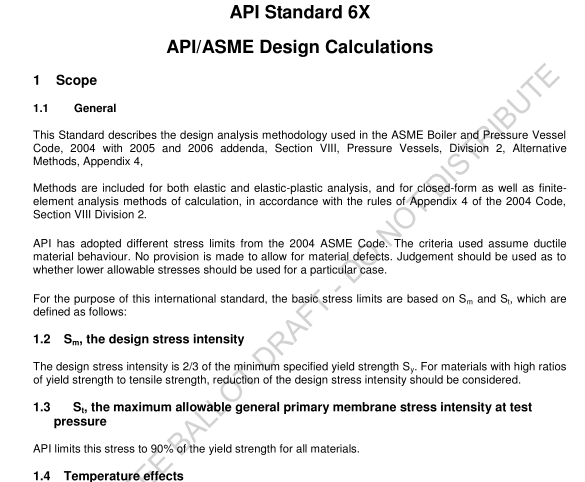API STD 6X pdf download

API STD 6X pdf download API Standard 6X API/ASME Design Calculations
For elastic analysis stress components are calculated, combined, and compared to limits for each category of stress based on multiples of the Design Stress Intensity, S m , for the material in use and for the category of stress. Stress components are combined to find the stress intensity, which is defined as twice the maximum shear stress. This can be calculated as the difference between the largest and smallest of the three principal stresses.
4.2 Stress Categories
4.2.1 General The following categories are used to classify stresses based on the consequences of exceeding the yield strength in various manners:
4.2.2 Primary Stress
4.2.2.1 General The basic characteristic of primary stress is that it is not self-limiting, and failure, or at least gross distortion, can occur from one application of the loading. Primary stress is stress caused by the application of mechanical pressure, forces and moments. Primary stress includes both membrane and bending stress and is linearly distributed across the wall section. Local primary stress can redistribute, like in a threaded connector. Thermal stresses are not primary stresses.
4.2.2.2 Primary Membrane Stress Intensity Primary membrane stress intensity is calculated from the average values of the stress components through the wall of the vessel. Depending on the extent of the stress, it can be classified as either General or Local. General Primary Membrane Stress Intensity, P m : Membrane stress distributed in a way such that load redistribution cannot occur, and loading beyond the yield strength can proceed to failure. P m is limited to S m .
Local primary Membrane Stress Intensity, P L : The following is a direct quote from ASME Section VIII Division 2 Appendix 4: “Cases arise in which a membrane stress produced by pressure or other mechanical loading and associated with a primary and/or a discontinuity effect would, if not limited, produce excessive distortion in the transfer of load to other portions of the structure. Conservatism requires that such a stress be classified as a local primary membrane stress even though it has some characteristics of a secondary stress. A stressed region may be considered as local if the distance over which the stress intensity exceeds 1.1 S m does not extend in the meridional direction more than 1.0(Rt) 1/2 , where R is the midsurface radius of curvature measured normal to the surface from the axis of rotation and t is the minimum thickness in the region considered. Regions of local primary membrane stress which exceed 1.1 S m shall not be closer in the meridional direction than 2.5(Rt) 1/2 where R is defined as (R1 + R2)/2, and t is defined as (t1+ t2)/2, where t1 and t2 are the minimum thicknesses at each of the regions considered, and R1 and R2 are the midsurface radii of curvature measured normal to the surface from the axis of rotation at these regions where the membrane stress exceeds 1.1 S m . Discrete regions of local primary membrane stress, such as those resulting from concentrated loads acting on brackets, where the membrane stress exceeds 1.1 S m shall be spaced so that there is no overlapping of the areas in which the membrane stress exceeds 1.1 S m . An example of a local primary membrane stress is the membrane stress in a shell produced by external load and moment at a permanent support or at a nozzle connection.”
.2.2.3 Primary Bending Stress Intensity The components of primary bending stress intensity P b are calculated from the linear primary stress component distributions that have the same net bending moment as the actual stress component distribution. Bending stress components are defined as being proportional to the distance from the centroid of a solid section. When the bending stress components are combined with the membrane stress components at each surface, the resulting stress intensities P m +P b are limited to 1 .5 S m .
4.2.3 Secondary Stress Secondary stress Q is caused by the constraint of adjacent parts or by self-constraint of the structure, and yielding can cause the magnitude of the stress to be reduced. One load cycle can cause local yielding and stress redistribution but cannot result in failure or gross distortion. Secondary stresses are membrane plus bending stresses that can occur at gross structural discontinuities, from general thermal stress, from mechanical preload conditions, or from combinations of these sources.









